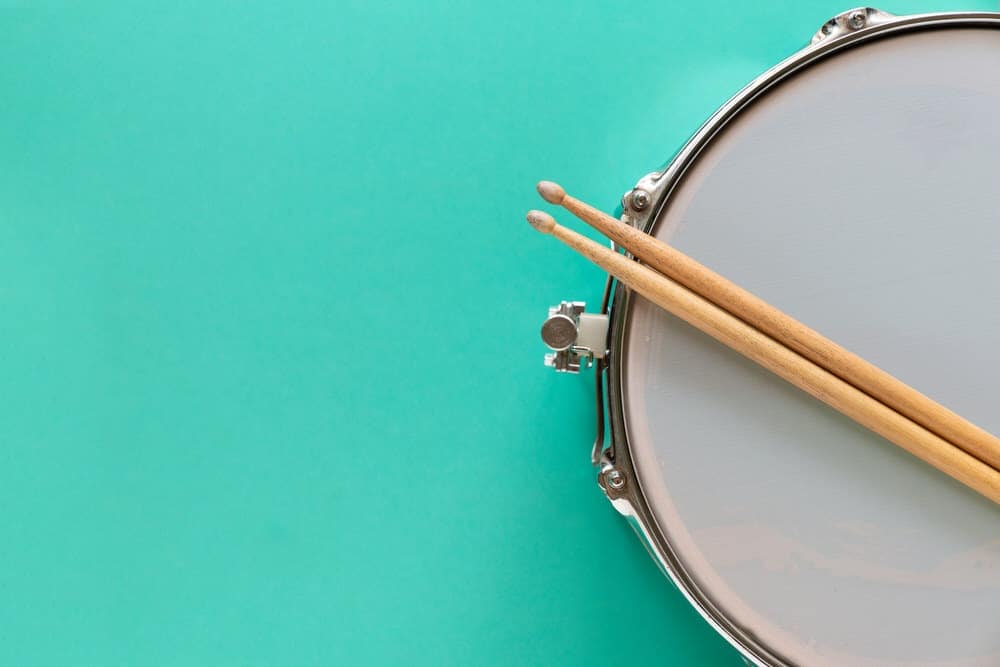Drums Learning Methods
The best way to learn the Drums
Dive into our Beginner’s Guide To Learning The Drums series, and uncover the secrets to discovering the perfect learning path that fits like a glove with your unique situation. It’s like choosing between chocolate and vanilla, so make sure you know what suits your tastes. Start your musical adventure today and see how these tips can make learning more fun and personal!

Most important choices for Drum Learning Methods
Humans learn in different ways. Some have got photographic memories; some can speed read, while others can’t read whatsoever. We are all distinct, and because of this, there isn’t one ‘correct’ technique of studying a musical instrument.
The four vital learning strategies that exist are:
- Traditional, face-to-face, one-to-one learning
- Traditional, face-to-face, group lessons
- Video Tutorials
- Apps
Whatever your own personal situation, one of those four choices will be well suited for you. We only need to discover which one…

Traditional, face-to-face, one-to-one classes
If you think of drum lessons, this is probably what you imagine. A one-to-one lesson, either at the teacher’s house, a purpose-built music room, or even the teacher coming to your house to teach you on your own drums.
Teaching at your own house has the advantage that you will be playing on your own kit and you don’t have to travel of course.
Having lessons at a purpose-built music studio either at the teacher’s house or another building can often mean that it is set up to listen to music loud enough to play along to. In an ideal set-up there might be two drum kits set up opposite each other, so the teacher can play one and you can play the other. This is especially useful if you are opposite-handed to your teacher (ie, if you are a left-handed player who sets up their drum kit left-handed but your teacher is right-handed).
There really is no substitute for having one-to-one lessons with the right teacher for you. It can be an incredible experience that encompasses so much more about learning music than just playing the drums. Mine taught me so much about the music business in general and what makes not just a good drummer but also a good musician. Make sure it’s the right teacher for you though – do you want to learn heavy metal? Jazz? Reading showband music? How much experience has the teacher had in these different areas? I was personally very lucky to have the world-renowned Paul Brodie teach me as he only lived a few miles away from where I grew up and I can honestly say, to this day, I always still think about nuggets of information he taught me about playing the drums every time I sit down at the kit.
There is a problem though:
Not every teacher has the experience of Paul Brodie/Ruth Nye.
In fact, the scary thing is to become a music teacher on any instrument, you don’t need any qualifications at all. Nothing. Nada. It could be someone with terrible technique who’s been kicked out of every band they were in, who funnily enough now has lots of time on their hands and is quite happy to take your money.
The drums are a very physical instrument and bad technique can cause you all sorts of injuries and pain down the line.
And this is the biggest downside with a traditional teacher:
Quality control.
You need to find a really experienced teacher who you connect with. Who understands you and your needs. Who makes you laugh. Who you look forward to seeing every week. If you can find that teacher, you have then achieved something most people fail at. Being inspired to play and motivated to learn is the biggest gift a teacher can give you.
Out of all the options on this page, this is the most expensive. But with most things in life, you get what you pay for.

PROS
- Personalised feedback
- Lessons Adapted To Your Style Of Learning
- The Most Efficient Way Of Learning
- Can Be The Most Inspiring Option
CONS
- Expensive
- Difficult Scheduling
- Finding Right Teacher Is Difficult
- Requires You To Travel
Conventional, face-to-face, Group sessions

Depending on where you live, you may be able to discover group classes. The ethos is much like one-to-one trainings, though the charges are much lower as the teacher needs to divide their time between all of the students.
For orchestral musical instruments, for instance violins, team lessons are quite a smart idea to get started with. Nearly all professional violinists of course find themselves as one of many violins in an orchestra. The drums is slightly different however. It is very much a solo instrument.
How many times have you ever seen drummers playing together in a group? Thought not…
PROS
- Personalised feedback
- Can Be Fun Learning In A Group
- Cheaper Than One-2-One Lessons
CONS
- Difficult Scheduling
- Limited Choice Of Teacher
- You'll Learn At The Speed Of The Group
- Sharing The Teacher With Others
- Requires You To Travel
Video Tutorials
Free Courses

YouTube is definitely the greatest source of training videos in the world. There is absolutely no greater place than YouTube to discover instructional information for the drums. Due to the sheer level of options on the platform, it’s out of the question to review all of them.
Like most mass appeal platforms, 95% of content is complete rubbish, with the other 5% no cost gold dust. Finding that 5% however is certainly difficult!
By far the best place to start for learning drums is the youtube channel, Drumeo. They have over a million subscribers, have plenty of free videos and are usually well recorded and look and sound super clear. They also have drummers that specialise in different technique so you can start following the ones that interest you.
You can start with the free lessons and pay as you go.
For those who would prefer to not shell out your money, and to take advantage of the free material on YouTube, you’ll need to spend a decent amount of energy looking for a well-respected coach that you like.
Paid Courses

With an incredible number of paid lessons on the internet, it’s totally impossible to review them all. Therefore we thought we would simply give you the most widely used choice:
PROS
- Low Cost or Free
- Huge Amount of Content
- Learn Whenever You Want
- No Travelling To Lessons
- Great For Popular Material
CONS
- So Much Choice It's Difficult To Find Great Content
- Quality of Content Is Questionable
- Not Great For Classical Playing
About the Author
Robert Emery
Robert Emery is Founder & CEO of Ted's List. He has performed all around the world as a conductor and pianist. From Sydney Opera House to the Royal Albert Hall, Robert has enjoyed bouncing around on stage in most of the major venues in the world. As a record producer, he has worked on fifteen No 1 albums, and hopes he can get to sixteen asap!
The Times called him 'the eccentric barefooted maestro' and the Mail quoted that 'the assured baton was controlled by the rather energetic and brilliant conductor'.
Robert has a wife (Mrs. E), two children (Master T and Master A) and four cats (Merlin, Mulberry, Partridge & Penguin). Between performing, producing, composing and running Ted's List, he runs an entertainment business called The Arts Group, comprising of a symphony orchestra, choir, live event production house, digital TV company and artist agency. Any spare time is usually devoted to sleep.
Other posts by this author
Zoom Lessons

If you’re looking for that one-to-one setup, but don’t want to trek around to a teachers house every week, then online lessons can work really well.
There are A LOT of companies out there that do lessons over Zoom, so you have to be ultra careful the quality is up to scratch. But the service we have found that has consistently great feedback is www.lessonwithyou.com. We like that they offer a half-hour lesson completely for free so you can try out the service and that they offer flexible scheduling with no contracts. They have teachers from Julliard, Berkeley, and Johns Hopkins – so the standard is high. Lastly, we LOVE that they don’t as for your credit card details for the trial lesson.

Bonus Courses...
Shiela E. Teaches Drumming and Percussion
Masterclass is the premier tuition service currently available. Non of the classes are designed to make you an expert. They are designed to help you ‘dip your toe’ into your genre of choice, and then use the platform to jump off into more specialised learning.
Sheila E – yes, THE Sheila E! – teaches the drum course. It is more of a taster than getting into the nitty-gritty of drumming but she is very inspiring so if you have the subscription anyway, it well worth checking her out.
The main disadvantage for online lessons is there is no one to check your technique out and as mentioned above, this can lead to injury and problems down the line without this being complemented by in-person lessons.
Drums Learning Methods - Summary
As with most things in life, what you get is what you pay for. Having said that, literally anyone can become a private music teacher and charge whatever they like. It’s an investment in your future, so take the time to find not only a great teacher, but a great teacher for YOU.
Group lessons, YouTube lessons etc. are a great place to start, but ultimately, you’ll need an actual, human teacher to help make sure you don’t develop bad habits. However, the internet can be a very inspiring place!
Subscribe Below – Or Miss Out…
Did you lose out last Friday? It only occurs once a week, and unless you’re registered, you’ll not learn about the spectacular things I’ve discovered for you this week.
At the end of a week, I’ll send you an email with the interesting items I’ve found.
It could literally be about anything at all related to music. It’ll end up in the e-mail if I believe you’ll love it!
Touring the planet as a music performer means I get to enjoy stuff you wouldn’t believe, and sharing it with you makes a lovely end to your week. Subscribe cost-free beneath.
Read the next post in this series:






